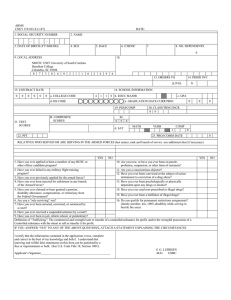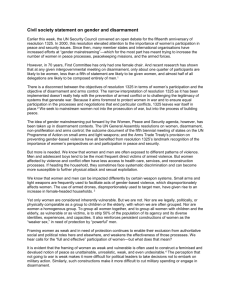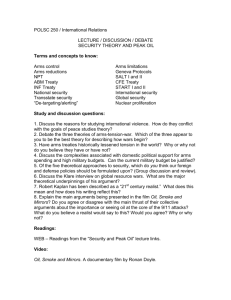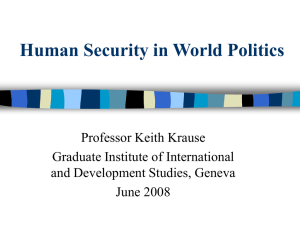Africa’s missing billions International arms flows and the cost of conflict
advertisement
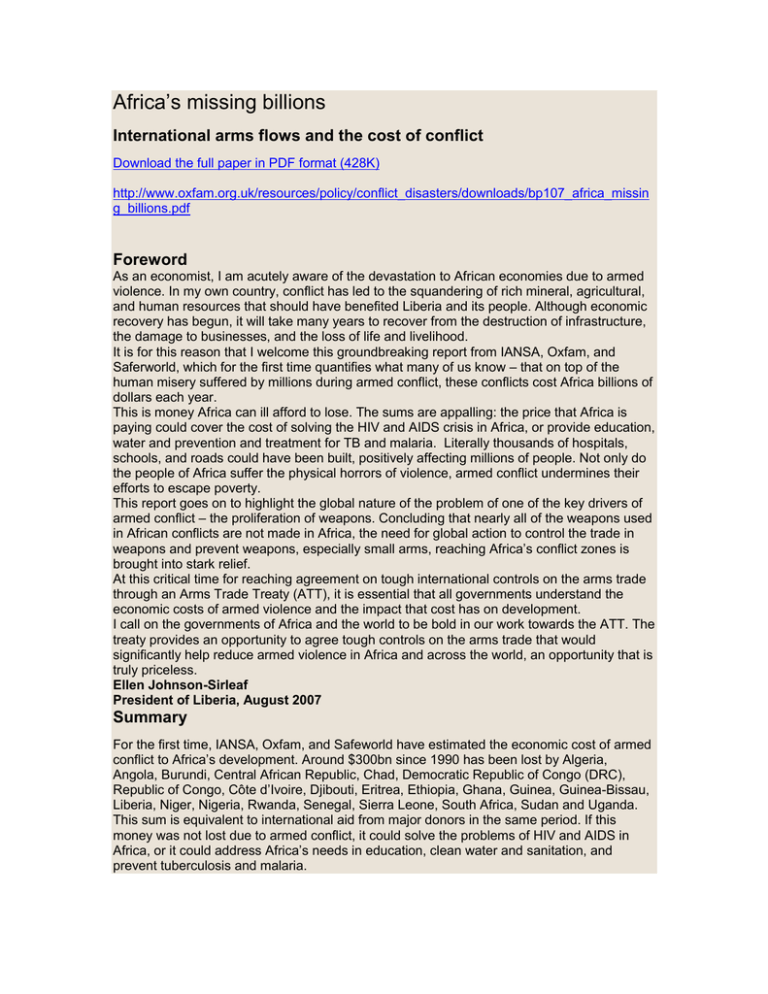
Africa’s missing billions International arms flows and the cost of conflict Download the full paper in PDF format (428K) http://www.oxfam.org.uk/resources/policy/conflict_disasters/downloads/bp107_africa_missin g_billions.pdf Foreword As an economist, I am acutely aware of the devastation to African economies due to armed violence. In my own country, conflict has led to the squandering of rich mineral, agricultural, and human resources that should have benefited Liberia and its people. Although economic recovery has begun, it will take many years to recover from the destruction of infrastructure, the damage to businesses, and the loss of life and livelihood. It is for this reason that I welcome this groundbreaking report from IANSA, Oxfam, and Saferworld, which for the first time quantifies what many of us know – that on top of the human misery suffered by millions during armed conflict, these conflicts cost Africa billions of dollars each year. This is money Africa can ill afford to lose. The sums are appalling: the price that Africa is paying could cover the cost of solving the HIV and AIDS crisis in Africa, or provide education, water and prevention and treatment for TB and malaria. Literally thousands of hospitals, schools, and roads could have been built, positively affecting millions of people. Not only do the people of Africa suffer the physical horrors of violence, armed conflict undermines their efforts to escape poverty. This report goes on to highlight the global nature of the problem of one of the key drivers of armed conflict – the proliferation of weapons. Concluding that nearly all of the weapons used in African conflicts are not made in Africa, the need for global action to control the trade in weapons and prevent weapons, especially small arms, reaching Africa’s conflict zones is brought into stark relief. At this critical time for reaching agreement on tough international controls on the arms trade through an Arms Trade Treaty (ATT), it is essential that all governments understand the economic costs of armed violence and the impact that cost has on development. I call on the governments of Africa and the world to be bold in our work towards the ATT. The treaty provides an opportunity to agree tough controls on the arms trade that would significantly help reduce armed violence in Africa and across the world, an opportunity that is truly priceless. Ellen Johnson-Sirleaf President of Liberia, August 2007 Summary For the first time, IANSA, Oxfam, and Safeworld have estimated the economic cost of armed conflict to Africa’s development. Around $300bn since 1990 has been lost by Algeria, Angola, Burundi, Central African Republic, Chad, Democratic Republic of Congo (DRC), Republic of Congo, Côte d’Ivoire, Djibouti, Eritrea, Ethiopia, Ghana, Guinea, Guinea-Bissau, Liberia, Niger, Nigeria, Rwanda, Senegal, Sierra Leone, South Africa, Sudan and Uganda. This sum is equivalent to international aid from major donors in the same period. If this money was not lost due to armed conflict, it could solve the problems of HIV and AIDS in Africa, or it could address Africa’s needs in education, clean water and sanitation, and prevent tuberculosis and malaria. Our research estimates that Africa loses around $18bn per year due to wars, civil wars, and insurgencies. On average, armed conflict shrinks an African nation’s economy by 15 per cent, and this is probably a conservative estimate. The real costs of armed violence to Africans could be much, much higher. The costs are incurred in a huge variety of ways. There are the obvious direct costs of armed violence – medical costs, military expenditure, the destruction of infrastructure, and the care for displaced people – which divert money from more productive uses. The indirect costs from lost opportunities are even higher. Economic activity falters or grinds to a halt. Income from valuable natural resources ends up lining individual pockets rather than benefiting the country. The country suffers from inflation, debt, and reduced investment, while people suffer from unemployment, lack of public services, and trauma. More people, especially women and children, die from the fall-out of conflict than die in conflict itself. The research carried out for this report has estimated that the cost of armed conflict to Africa’s development has been a shocking $284bn since 1990. Although high, this is almost certainly an under-estimate. For a start, this calculation only covers the cost of armed conflict, not armed crime. Further, our calculation only covers periods of actual combat but some costs of war, such as increased military spending and a struggling economy, continue long after the fighting has stopped. Neighbouring countries also suffer economically, due to reduced trade, political insecurity, or an influx of refugees. The evidence also suggests that at least 95 per cent of Africa’s most commonly used conflict weapons come from outside the continent. The most common weapon is the Kalashnikov assault rifle, the most well-known type being the AK-47, almost none of which are made in Africa. A steady supply of ammunition is required to keep arms deadly, but little military ammunition is manufactured in Africa. Although it is impossible to demonstrate precisely, our research suggests that the vast majority of ammunition has to be imported from outside Africa. If armed violence is this costly and most of the weapons come from outside Africa, then Africa desperately needs to stop the flow of arms to those who abuse human rights and ignore the rules of war. As well as looking at the demand for weapons, strong initiatives must be taken to restrict supply. Many African nations, recognising the threat to their development from irresponsible arms transfers, have already made significant efforts towards arms control. However, many African governments feel let down by the international community. They know that the arms trade is globalised, and that national or regional regulations, although absolutely vital, are not enough. Africa, as elsewhere, needs new international standards on arms transfers – a strong and effective Arms Trade Treaty (ATT). Such a treaty would not prevent the responsible transfer of weapons for defence, policing, peacekeeping, and other legitimate purposes, but it must prohibit arms transfers if they are likely to be used to: • Commit serious violations of international humanitarian law; • Commit serious violations of international human rights law; • Undermine sustainable development. Although the causes of armed violence are many and highly complex, and require a variety of actions to be taken, we believe that an ATT based on these principles would be one important tool in reducing armed violence in Africa. At the moment, there are international negotiations working towards such a treaty. So far, African support for an ATT has been crucial to its success. Negotiations in the United Nations are reaching a critical stage. It is vital for governments, in Africa and around the world, to support these negotiations and demand a strong result. There is an urgent need to reduce the international supply of arms and ammunition to Africa. Otherwise the cost to African development – measured not just in dollars wasted but in lives shattered and opportunities squandered – will remain immense. Date of publication: October 2007

